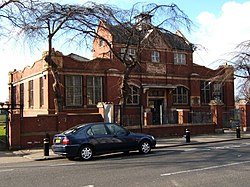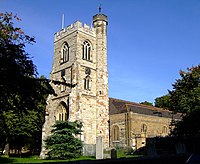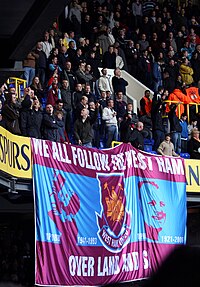West Ham
| West Ham | |
| Essex | |
|---|---|
 West Ham Library | |
| Location | |
| Grid reference: | TQ405837 |
| Location: | 51°32’5"N, -0°0’28"E |
| Data | |
| Post town: | London |
| Postcode: | E13, E15 |
| Dialling code: | 020 |
| Local Government | |
| Council: | Newham |
| Parliamentary constituency: |
West Ham |
West Ham is an entirely urban town in Essex, within the metropolitan conurbation. In the west it is a post-industrial neighbourhood abutting the site of the new London Olympic Park and in the east it is mostly residential, consisting of Victorian terraced housing interspersed with higher density post-War social housing. The area has been one of the most deprived in the country. The place lends its name to West Ham United Football club, whose colours are see displayed across West Ham and beyond.
West Ham is within the Becontree Hundred of Essex.
History
Foundation and name

A settlement in the area named Ham is first recorded as Hamme in an Anglo-Saxon charter of 958 and then in the 1086 Domesday Book as Hame. The earliest recorded use of West Ham, as distinct from East Ham, is in 1186 as Westhamma. The name is formed from Old English 'hamm' and means 'a dry area of land between rivers or marshland', referring the location of the settlement within boundaries formed by the rivers Lea, Thames and Roding and their marshes.[1]
West Ham formed a large ancient parish of around 4,500 acres. The parish was divided into three wards: Church-street, Stratford-Langthorne, and Plaistow. The village of West Ham corresponds to the Church-street ward. The parish also included the hamlet of Upton, now a contiguous urban neighbourhood.
The first railway station in the area opened in 1839 at Stratford, and consequently the focus of activity shifted northwards towards the fast-expanding Stratford, while the original parent settlement diminished in significance.
In 1840 the parish was included in the Metropolitan Police District and soon after the built-up area of London had encompassed West Ham and Stratford. In 1889 a West Ham County Borough was created, encompassing the old parish, which lasted until 1965.
Geography and transport
West Ham is south of Stratford. West Ham station on Manor Road is served by the London Underground Jubilee, Hammersmith and City and District lines; the National Rail c2c services; and from 2010 the Docklands Light Railway. Plaistow and Stratford stations are also close by.
Post-industrial land and a network of waterways, the Bow Back Rivers, separate West Ham from Bromley-by-Bow. To the north and east the area bleeds into Stratford and Plaistow, with Canning Town to the south. The array of transport available which links West Ham to the rest of the City of London has made West Ham a sought-after location to reside in, though by no means a prestigious one.
Sport

The football club West Ham United FC is named after the area. Their nicknames, the Irons and the Hammers derive from their association with the Thames Ironworks and Shipbuilding Company, whose workers formed Thames Ironworks FC. West Ham FC have played at the Boleyn Ground in nearby Upton Park since 1904. The West Ham Stadium, a football, greyhound racing and speedway stadium, operated between 1928 and 1972, with a capacity of 120,000. The street names of housing developed on the site of the former stadium pay homage to the speedway greats associated with West Ham, including Bluey Wilkinson and Jack Young. The West Ham Hammers team were involved in the top flight leagues 1929 to 1939, 1946 to 1955 and 1964 to 1971, winning the inaugural British League in 1965.[2]
While football is probably the main focus for the community, there is quite a lot of interest in other sports, including rugby. Next to West Ham station, on Holland Road, is the home of 3 rugby teams, all playing in Essex RFU leagues: Phantoms RFC, King's Cross Steelers and East London RFC.
See also
References
- ↑ Mills, A.D. (2001). Dictionary of London Place Names. Oxford.
- ↑ Speedway information on West Ham accessed 11 May 2007